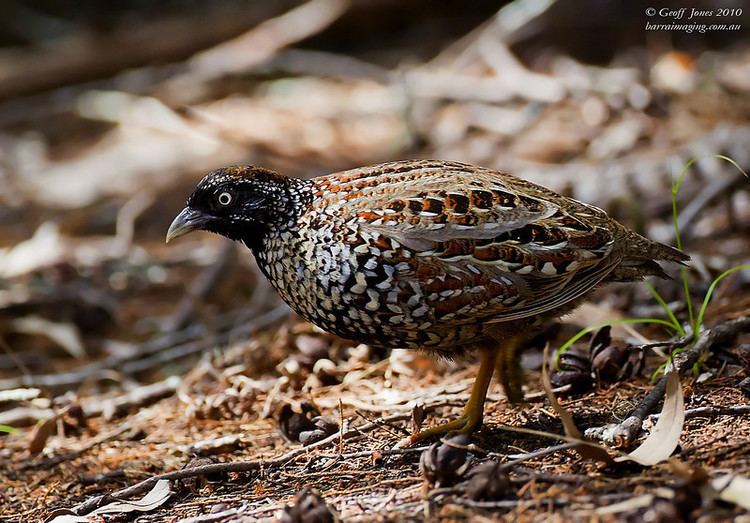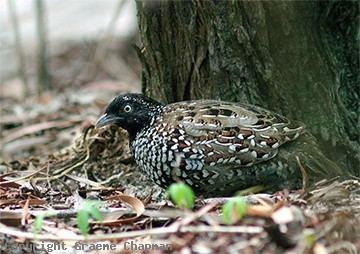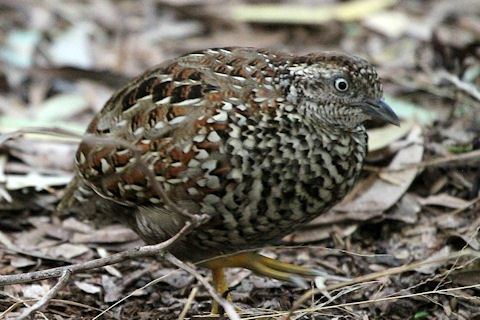Genus Turnix Phylum Chordata Rank Species | Family Turnicidae Scientific name Turnix melanogaster Higher classification Turnix Order Shorebirds | |
 | ||
Similar Buttonquail, Turnix, Buff‑breasted buttonquail, Chestnut‑backed buttonquail, Painted buttonquail | ||
The black-breasted buttonquail (Turnix melanogaster) is a rare buttonquail endemic to eastern Australia, where it is usually found in rainforest. Like other buttonquails, it is unrelated to the true quails. The black-breasted buttonquail is a plump quail-shaped bird of predominantly marbled black, rufous and pale brown, marked prominently with white spots and stripes, and white eyes. Like other buttonquails, the female is larger and more distinctively coloured than the male. Measuring up to 20 cm (8 in), it has a black face and chin, sprinkled with fine white markings. The smaller male measures up to 18 cm (7.5 in) and lacks the black markings.
Contents

Taxonomy

The black-breasted buttonquail was originally described by ornithologist John Gould in 1837 as Hemipodius melanogaster. Its specific epithet is derived from the Ancient Greek terms melano- "black", and gaster "belly". Along with other buttonquails, the black-breasted buttonquail was traditionally placed in the order Gruiformes, but more recent molecular analysis shows it belongs to an ancient lineage of shorebirds (Charadriiformes).
Black-fronted buttonquail is an alternate name.
Description

The black-breasted buttonquail is a plump quail-shaped bird of predominantly marbled black, rufous and pale brown, marked prominently with white spots and stripes, and white eyes. Like other buttonquails, the female is larger and more distinctively coloured than the male. Measuring up to 20 cm (8 in), it has a black face and chin, sprinkled with fine white markings. The smaller male measures up to 19 cm (7.5 in) and lacks the black markings. The black markings and large size of the female and the dark markings and whitish face of the male distinguish the species from the painted buttonquail.
The female makes a low-pitched oom call.
Distribution and habitat

The black-breasted buttonquail is found from Hervey Bay in central Queensland south to the northeastern corner of New South Wales, generally in areas receiving 770–1200 mm (30–48 in) rainfall annually. It is rare and its habitat fragmented. It is found in rainforest and nearby areas, as well as bottle tree (Brachychiton rupestris) scrub, hoop pine (Araucaria cunninghamii) plantations, and lantana thickets. It is found in Palmgrove National Park, which has consequently been identified by BirdLife International as an Important Bird Area for the species.

The black-breasted buttonquail was once populous on Inskip Point near Fraser Island, with the area a destination for birdwatchers wanting to see this species. However, there were fears that they had suffered predation. Mike West, former president of Birds Queensland, blamed dingoes and wild dogs for wiping out the population. However, as of early 2014, Queensland Parks and Wildlife staff believe that at least two pairs are still present at Inskip Point.
Conservation status

The species was classified as vulnerable until 2012 when it downlisted to near threatened; most of the black-breasted buttonquail's original habitat has been cleared and the remaining populations are fragmented. The population has been estimated at as little as 2500 breeding birds and declining, it is listed as vulnerable in Queensland and listed as "near threatened" on the IUCN Redlist.
Breeding
The usual sex roles are reversed in the buttonquail genus, as the larger and more brightly-coloured female mates with multiple male partners and leaves them to incubate the eggs. One or two broods are probably laid each year; the nest is a shallow depression scraped out of the leaf litter and ground, lined with dried vegetation. Three or four shiny grey-white or buff eggs splotched with dark brown-black and lavender are laid measuring 28 mm x 23 mm.
